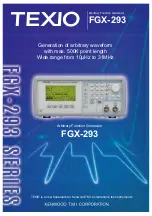
©
National Instruments Corporation
39
NI 5402/5406 Calibration Procedure
Adjustment
If the NI 5402/5406 successfully passes all verification within the
calibration test limits, NI recommends adjustment to guarantee its
published specifications for the next two years. If you choose not to adjust
your device, refer to the
Updating the Calibration Date and Temperature
section for instructions on updating the calibration date and temperature
without performing an adjustment. If the NI 5402/5406 is not within
the calibration test limits for each verification procedure, perform the
adjustment procedure to improve the accuracy of the NI 5402/5406. Refer
to
Appendix A: Calibration Procedure Options
for more information on
which procedures to perform.
The external calibration procedure adjusts the onboard calibration A/D
converter (ADC), the oscillator frequency, the analog output, and the
flatness correction.
Calibration ADC adjustment
characterizes the onboard
ADC gain and offset so that self-calibration results in an accurately
calibrated device.
Oscillator frequency adjustment
characterizes the
onboard oscillator to ensure frequency accuracy.
Analog output adjustment
characterizes the DC gains and the offsets of the main and square wave
analog path to ensure the analog output voltage accuracy.
Flatness
Correction adjustment
characterizes the sine wave flatness correction
applied to generated sine waves.
To perform an adjustment, create an external calibration session by calling
the niFgen Init Ext Cal VI. Along with the standard NI-FGEN attributes,
the external calibration session uses a set of calibration constants that are
determined during the calibration procedure and stored in the device
onboard memory when the session is closed. NI-FGEN uses these
calibration constants during a standard NI-FGEN session to ensure that the
device operates within its specifications. You must close an external
calibration session by calling the niFgen Close Ext Cal VI.
















































